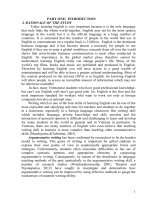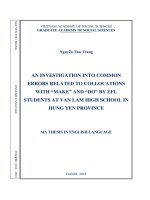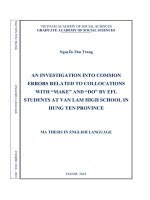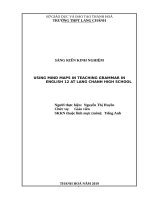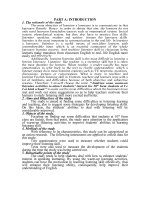HOW TO MOTIVE STUDENTS AT LANG CHANH HIGH SCHOOL TO LEARN ENGLISH BY USING MUSIC IN THE LESSON UNIT 12 PART a READING ENGLISH 10 TEXTBOOK
Bạn đang xem bản rút gọn của tài liệu. Xem và tải ngay bản đầy đủ của tài liệu tại đây (1.31 MB, 21 trang )
Category
Content
Page
I. Introduction:
4
1. Reason for choosing the topic
4
2. Aims of the study
3. Scope of the study
5
II. Content / Development
1. Theoretical background
6
2. Practical background
9
3. The solutions
11
4. The discussion
17
III. Conclusion
18
IV. References
19
5
6
1
THE DETAILED OUTLINE
Title: HOW TO MOTIVE STUDENTS AT LANG CHANH HIGH SCHOOL
TO LEARN ENGLISH BY USING MUSIC IN THE LESSON
"UNIT 12. PART A. READING - ENGLISH 10 TEXTBOOK"
I. Introduction
1. Reason for choosing the topic
- Social development and national renewal is urgently required to improve the
quality of education and training.
- The roles of English: playing a vital role in the development of our society.
- The curriculum
- Problems students face
- What the teacher have done to solve the problems
- Effective solutions
2. Aims of the study.
- To introduce the importance of music in daily life.
- To show many kinds of music in the world in general, in Viet Nam in specific.
- To bring teachers confidence in giving a lecture.
3. Scope of the study
The qualitative and quantitave approach
II. Contents / Development
1.Theoretical background : The benefits of music
2. Practical background :
- The real situation in students' English leaning
- The reality of quality of English at Lang Chanh High School.
3. The solutions
4.The discussion
III. Conclusion
1. General summary:
2. Suggested approaches to solve similar problems
2
IV. References
- Websites
V. Appendices
- Surveys
- Observations
THANH HOA DEPARTMENT OF EDUCATION AND TRAINING
3
LANG CHANH HIGH SCHOOL
THANH HÓA, 2019
EXPERIENCE INITIATIVE
Title: HOW TO MOTIVE STUDENTS AT LANG CHANH HIGH
SCHOOL TO LEARN ENGLISH BY USING MUSIC IN THE LESSON
"UNIT 12. PART A. READING - ENGLISH 10 TEXTBOOK"
The writer: Hoàng Khắc Hạnh
Position: Assistant Headmaster
Experience initiative: English
I. INTRODUCTION
1. Reason for choosing the topic
English, which is the common language in the world, is an important
subject in schools. Being thoroungly awared of the importance of this language
in international communication as well as in the development of international
integration, Vietnamese educators should use English as the key subject .
English is essential for not only the tourism industry, foreign trade, foreign
companies, computer users but also high school graduates. Therefore, each
student attending high school must have a certain level of English to prepare for
exams and after graduating at least they are able to communicate, read and write
some normal texts. To do this, we are constantly innovating teaching methods
and curriculum to achieve substantive results for general English courses and
forging some basic skills for students.
During English learning process, finding the way to obtain English
knowledge is the most important. Teachers must possess many skills to be
successful in the classroom. A level of expertise is needed to translate subject
matter into curricular goals for specific grade levels. Teachers must understand
how students develop and what motivates them to learn. Teachers must also be
able to implement pedagogical skills to make the subject matter applicable to all
4
students, with the ability to assess for future learning (Darling-Hammond &
Baratz-Snowden, 2005). In addition, the unpredictability of the classroom
requires a level of organization that is imperative for successful learning to take
place (Emmer & Stough, 2008; Darling-Hammond & Baratz-Snowden, 2005).
Organization is the foundation of any classroom and can be created and
maintained through effective classroom management strategies (Freiberg, 1999).
The teacher, as manager, must oversee the learning environment while
protecting instructional time, maintaining the flow of the class, and being
attentive to the needs of each student (Darling-Hammond & BaratzSnowden,
2005). When management strategies are in place, the classroom can become a
successful learning environment for all students. Conversely, when management
strategies are not in place, several student concerns can result, including lack of
student participation, excessive talking, and general misbehaviors (Blair, 2008;
Jones, 2006; LePage, DarlingHammond, Akar, Gutierrez, Jenkins-Gunn, &
Rosebrock, 2005). The effort necessary to manage a successful learning
environment often surprises new teachers; even those experienced with schoolaged children are unprepared for the different challenges that arise, once in the
classroom (Berg, 2004). This has led many beginning teachers to doubt their
abilities and choice of profession, as well as question the quality of their
preservice preparation (Anhorn, 2008; Conway, 2002; Hourigan & Scheib,
2009; Nahal, 2010; Roulston
2. Aims of the study.
- To introduce the importance of music in daily life.
- To show many kinds of music in the world in the general, in Viet Nam in
specific.
- To bring teachers confidence in giving a lecture by themselves.
3. Scope of the study :
This study is only concerned with ways of organising activities in the
class rather than with teaching techniques.
II. CONTENTS
5
1. Theoretical background: The benifits of music
The first step is to begin with making sure that teachers understand how
important music is in daily life.
1.1. Music plays a vital part in daily life
We can experience music almost everywhere: on the street, at a concert, in
our homes, on our phones or radios, in school, and even in classrooms. It would
be impossible for a day to go by without music. It helps people release stress.
Regardless of our interests and talents in music, we can all greatly benefit from
experiencing music, particularly in the school environment. In fact, did you
know that exposure to music can improve learning and increase positive
classroom atmosphere . During developmental stages, active engagement with
music can impact the way that the brain can process information, enhancing the
perception of language and speech, and subsequently improving our ability to
communicate with others and learn to read. Several studies on the effects of
experiencing calm music have suggested that it can reduce aggressive behavior
and regulate moods, particularly feelings of anxiety and stress.
1.2. Music brings a lot of benefits to students in students' learning
process
When students are able to manage their emotions in more positive ways,
students are able to enhance their learning potential.
Nearly everyone enjoys music, whether by listening to it, singing, or playing an
instrument. But despite this almost universal interest, many schools are having
to do away with their music education programs. This is a mistake, with schools
losing not only an enjoyable subject, but a subject that can enrich students’ lives
and education. Read on to learn why music education is so important, and how it
offers benefits even beyond itself.
Musical training helps develop language and reasoning: Students who
have early musical training will develop the areas of the brain related to
language and reasoning. The left side of the brain is better developed with
music, and songs can help imprint information on young minds.
6
A mastery of memorization: Even when performing with sheet music,
student musicians are constantly using their memory to perform. The skill of
memorization can serve students well in education and beyond.
Students learn to improve their work: Learning music promotes
craftsmanship, and students learn to want to create good work instead of
mediocre work. This desire can be applied to all subjects of study.
Increased coordination: Students who practice with musical instruments
can improve their hand-eye coordination. Just like playing sports, children can
develop motor skills when playing music.
A sense of achievement: Learning to play pieces of music on a new
instrument can be a challenging, but achievable goal. Students who master even
the smallest goal in music will be able to feel proud of their achievement.
Kids stay engaged in school: An enjoyable subject like music can keep
kids interested and engaged in school. Student musicians are likely to stay in
school to achieve in other subjects.
Success in society: Music is the fabric of our society, and music can shape
abilities and character. Students in band or orchestra are less likely to abuse
substances over their lifetime. Musical education can greatly contribute to
children’s intellectual development as well.
Emotional development: Students of music can be more emotionally
developed, with empathy towards other cultures They also tend to have higher
self esteem and are better at coping with anxiety.
Students learn pattern recognition: Children can develop their math and
pattern-recognition skills with the help of musical education. Playing music
offers repetition in a fun format.
Better SAT scores: Students who have experience with music performance
or appreciation score higher on the SAT. One report indicates 63 points higher
7
on verbal and 44 points higher on math for students in music appreciation
courses.
Fine-tuned auditory skills: Musicians can better detect meaningful,
information-bearing elements in sounds, like the emotional meaning in a baby’s
cry. Students who practice music can have better auditory attention, and pick out
predictable patterns from surrounding noise.
Music builds imagination and intellectual curiosity: Introducing music
in the early childhood years can help foster a positive attitude toward learning
and curiosity. Artistic education develops the whole brain and develops a child’s
imagination.
Music can be relaxing: Students can fight stress by learning to play music.
Soothing music is especially helpful in helping kids relax.
Musical instruments can teach discipline: Kids who learn to play an
instrument can learn a valuable lesson in discipline. They will have to set time
aside to practice and rise to the challenge of learning with discipline to master
playing their instrument.
Preparation for the creative economy: Investing in creative education
can prepare students for the 21st century workforce. The new economy has
created more artistic careers, and these jobs may grow faster than others in the
future.
Development in creative thinking: Kids who study the arts can learn to
think creatively. This kind of education can help them solve problems by
thinking outside the box and realizing that there may be more than one right
answer.
Music can develop spatial intelligence: Students who study music can
improve the development of spatial intelligence, which allows them to perceive
the world accurately and form mental pictures. Spatial intelligence is helpful for
advanced mathematics and more.
8
Kids can learn teamwork: Many musical education programs require
teamwork as part of a band or orchestra. In these groups, students will learn how
to work together and build camaraderie.
Responsible risk-taking: Performing a musical piece can bring fear and
anxiety. Doing so teaches kids how to take risks and deal with fear, which will
help them become successful and reach their potential.
Better self-confidence: With encouragement from teachers and parents,
students playing a musical instrument can build pride and confidence. Musical
education is also likely to develop better communication for students.
2. Practical background
2.1. Students’ Lack of Motivation
Teachers expect students to demonstrate interest in class activities by being
engaged and persistent in accomplishing required tasks (Pintrich & Schunk,
1996). When they do not, several behaviors become evident, including lack of
participation, general apathy, and disinterest, as well as poor or no completion of
tasks (Allen, 1986; Pintrich & Schunk, 1996; Roehrig, Pressley, & Talotta,
2002). High school students in particular can frequently be lethargic and possess
an overall negative attitude towards school, presenting a greater motivational
challenge for high school teachers than teachers in the elementary and juniorhigh grades (Price, 1997; Roehrig et al., 2002; Veenman, 1984). While
participation in music ensembles has been found to motivate students in their
academic performance, motivation decreased as students got older, affecting
individual achievement and success of the music ensembles (Conway, 2002)
Students' negativity towards school exacerbates their disinterest in each class
setting, creating a challenging situation, especially for beginning teachers
(Roehrig et al., 2002). This 21 negativity may in turn cause teachers to treat
those students inequitably (Pintrich & Schunk, 1996; Skinner & Belmont, 1993).
For instance, students who were perceived as emotionally and behaviorally
engaged received more attention from the teacher (Skinner & Belmont, 1993).
This in turn encouraged those students to continue with demonstrated behavior.
On the other hand, teachers felt incompetent and disliked by students who were
passive and unengaged, causing the teacher to neglect those students by
providing less attention and assistance to them. This can become a cyclical
pattern between teacher and student, which can disrupt the academic growth of
the student (Skinner & Belmont, 1993).
9
2.2. The reality of quality of English learning at Lang Chanh High
School.
There are more than 1,200 students coming from various villages in Lang
Chanh district. Most of them are ethnic minority students, whose background is
not good enough, and they have shy characteristics . It means that teachers need
to be enthusiastic and patient in order to find out the most suitable and effective
teaching methods.
During the last ten years, the implementation of innovation of teaching
method in lang Chanh High school in general, in Foreign Language group
particularly has initially gained encouraging results. The majority of teaching
lessons are taught using active appropriate teaching methods for each skill
lessons and different units, such as: Pair-work, Group work, role-play, centered
Learner, visual aids, etc. How to choose the teaching methods depends on the
topic of the lesson and the knowledge level of each group. From what I have
experienced, I found that one of the most practical methods at high Lang Chanh
High School is using visual aids during the English lessons. The quality of
English learning at school has been gradually ỉmproved . Furthermore, English
lessons have attracted more and more students. Students are getting more and
more active during the class in which they can discuss with their partners about
the content of the lessons.
In fact, using visual aids in class sometimes is not practical and
appropriate. Therefore, I want to talk about how to use music in the lesson
"Unit 12. Music - part A. Reading, English 10 textbook" effectively, which
encouages students to be absorbed in the lecture.
I hope that this study will contribute to improving the effectiveness of
teaching and learning English at high schools in remote areas in general, at Lang
Chanh High School in specific.
3. Solutions
10
3.1. Some types of Vietnamese music
Mark Swed, the music critic for the Los Angeles Times, said that "Vietnam
probably has more musical styles per square mile than any other nation. Forms
of Vietnamese music include court music, hat cheo (traditional folk opera), hat
tuong (classical drama), hat cai luong (modern theater), quan ho (folks songs,
with dialogues sung between women and women), dân ca (folk music with
strong regional variations), ca tru (declamation songs), he songs, hat doi (men
and women love duet songs of the hill tribes) and ho chants . [Source: Music of
Vietnam , a 2 two CD set assembled by Eckart Rahn, Celestial Harmonies]
Hat cheo , hat tuong , and hat cai luong resemble Beijing Opera. About 70
percent of the drama is portrayed with songs with climatic high notes sung by
the actors and accompanied by an orchestra on the side of the stage. Cai Luong
was developed in the 1920s. It is a uniquely Vietnamese form of drama based on
characters from real-life. The art form is fading as the younger generation
becomes more interested in Western-style pop music.
There are three main styles of Vietnamese music: 1) the Hue style (with an
emphasis on solo pieces); 2) northern professional style (often accompanied by a
lute); and 3) southern amateur style (incorporates more western instruments such
as violins and Hawaiian guitars).
Vietnam has a genre of music specifically created for the dead and is
traditionally only played at funeals and cereomies hnoring tehd ead. The art of
playing has traditionally been handed throygh families and lmost died out in the
realy Communist erea. It has come back.
Before teaching the lesson "Unit 12. MUSIC - PART A. READING Period 75, English 10 textbook", I asked my students to prepare the lesson at
home : "Finding out some types of Vietnamese music as much as possible".
Group 1: "Huế" Court Music
11
Hue Court Music is the last vestige of Vietnamese Court Music. It contains
all the elements of of Vietnamese Court Music that have been established and
developed over 1,000 years. Ttherefore Hue Court Music is synonymous with
Vietnamese Court Music. Hue Court Music is large scale and highly
professional. As the official music of the state, it consists of many large scale
orchestras and many music and dance pieces performed by instrumentalists,
singers and dancers. Moreover, this music genre has a high degree of
improvisation and variation of the melodious scheme.
Group 2: "Ca Trù"
Ca Tru is a 600-year-old form of sung poetry that is kept alive by a few
eldery people and is in danger of dying out. It was hugely popular at one time.
The songs—about mandarins and courtesans, love and loneliness—once filled
the courts of Hue and drew large crowds at singing contests. Now many of the
singers that keep it alive are in their 80s. Ca tru singing was inscribed on the list
of Intangible Cultural Heritage in need of Urgent Safeguarding in October 2009.
Group 3: "Xoan" singing
Xoan singing in Phu Tho Province was inscribed as a UNESCO Intangible
Cultural Heritage in Need of Urgent Safeguarding in 2011. According to to
UNESCO: Xoan singing is practiced in Phú Tho. Province, Viet Nam, in the first
two months of the lunar year. Traditionally, singers from Xoan guilds performed
songs in sacred spaces such as temples, shrines and communal houses for the
spring festivals. There are three forms of Xoan singing: worship singing for the
Hùng kings and village guardian spirits; ritual singing for good crops, health and
luck; and festival singing where villagers alternate male and female voices in a
form of courtship. Each Xoan music guild is headed by a leader, referred to as
the trùm; male instrumentalists are called kép and female singers, Đào.
Group 4: "Quan họ" singing
12
Quan ho singing is a folk art of a highly collective nature. Those who sing
are not entertainers, but all are part of the performance, and anyone is welcome
to join. The birth place of quan ho folk songs is Bac Ninh Province. During
village festivals, which are held every year, particularly in spring, young men
and women gather in the yard of a communal house or pagoda, on a hill or in a
rowing boat, and sing quan ho. This is a style of singing where songs alternate
from group to group. In 2009, Quan ho Bac Ninh folk songs were inscribed on
the list of Representative List of the UNESCO Intangible Cultural Heritage of
Humanity for its cultural value, social custom preservation, performing arts,
style of contact, lyric and costume.
Group 5: "Then" singing
The then song is the religious music of the Tay, Nung minorities. This type
of song can be considered a religious performance of Long Poems which depict
a journey to the heavens to ask the Jade Emperor to settle trouble for the head of
the household.
Group 6: "Chầu văn" singing
Hat van or hat chau van, a traditional folk art which combines singing and
dancing, is a religious form of art used for extolling the merits of beneficent
deities or deified national heroes. Its music and poetry are mingled with a
variety of rhythms, pauses, tempos, stresses and pitches. Hat van, in essence, is a
cantillation where the tunes and rhythm depend on the contents of the sung text.
The tunes and rhythms may be linked together into a suite, used in relation to a
mythical occurrence with hints of features from modern life. The art of hat van
originated in the Red River Delta and dates back to the 16th century, later
spreading to the whole country. It has also adopted the essential beauty of folk
songs from the uplands and highlands of the North, Center and South. Hat van
requires both a learned and a folksy character, and it has attracted musicologists
at home and abroad.
13
3.2. Teaching procedure
Date of preparing: 06/3/2019
Date of teaching: 13/3/2019
Period 75
UNIT 12: MUSIC
PART A. READING
I. Objectives
1. Education aims: Students know more about the role of music in our
life.
2. Knowledge:
a. General knowledge: Knowledge about music.
b. Language:
The present simple tense.
Vocabulary concerning music: rock 'n 'roll, mournful, solemn......
3. Skills: - Speaking : talk in pairs and in groups.
-
Reading comprehension: better sts' reading skill through
sentence completing and answering questions.
II. Anticipated problems
- Students may not have enough words and knowledge about some kinds
of music.
- There would be many words that Ss do not understand.
- Some students won’t understand when the teacher gives instructions in
English.
Solutions:
- The teacher teaches some new vocabulary and instructs students to guess
the meaning of other new words based on the contexts.
- The teacher gives instructions as clearly as possible and checks
understanding carefully or the teacher may use Vietnamese to clarify the
instructions.
- Students find out more about some types of music and the role of music in
our life.
III. Teaching aids: board, textbook, chalk, tape.
14
IV. Procedures
Teacher’s activities
1. Warm-up (5')
Students’ activities
- Play the tape with 5 pieces of music and ask
sts to guess what types of music they are.
- Listen to the tape and guess.
- Get feedback and check.
- Stand up and say aloud the names
2. Before you read:( 10')
of the types of music.
Aims: To provide sts with words/phrases
...…...…...…
about music.
a. Matching
- Ask sts to work in pairs to match the
descriptions to the types of music given in the - Work in pairs to match.
part:
- Give answers orally.
- For each type of music, 2 sts from 2 pairs 1- b
are required to give their match orally.
2- e
3- d
4- a
5- c
- Others listen
- Listen and help sts to give correct match.
b.Vocabulary
- Provide sts with the new words/phrases:
+ Emotion (n) a strong feeling
+ Convey (v) = Show, express
- Listen and repeat.
+ Integral part (n) = necessary part
- Write down these words into their
+ Lull sb (v): >< wake sb up.
notebooks.
+ Delight (v): To make somebody happy.
+ Funera l (n): a funaral is celebrated when
someone dies.
+ Solemn (adj): serious, not happy
+ Mournful (adj): sad
- Read each word/phrase 3 times and ask sts
to repeat it.
- Leave sts 1 minute to self-practice.
15
- Ask 4-5 sts to read all the word/phrases
aloud in front of the class
- Listen and help sts to read the words/phrases
correctly.
3. While you read (15')
Aims: Read for information to do the
sentence
completing,
and
answering - Work individually.
excercises
- Report their answers sentence by
+ Task 1: Sentence completing.
sentence.
- Ask sts to read the passage indepently then 1. Communicate
use the words/ phrases in the box to complete 2. Lull
the sentences.
3. delights
- Tell sts to refer to Vocabulary for help and 4. integral part
encourage them try to guess the meanings of 5. solemn
the words in the context of the reading.
6. emotion
- Call on 7-8 sts to read and explain their 7. mournful
answers aloud in front of the class
- Feedback and give remarks.
+ Task 2: Questions answering.
- Ask sts to work in pairs to read the passage
more carefully and find the answers to the - Students do the work in pairs
questions given.
- Some pairs report their answers
- Ask sts to highlight or underline the while others watch.
information in the passage that helps them to 1. Language and music.
find the correct answers.
2. It can express ideas, thoughts and
feelings.
- Listen and help the students to give correct 3.
answers.
It
adds
joyfulness
to
the
atmosphere of a festival and make a
funeral more solemn and mournful.
16
4. It makes people happy and
excited. It delights the senses.
4. After you read ( 15')
5. It is a billion-dollar industry.
- The teacher asks the representative of each
group to introduce some kinds of Vietnamese - Present about some kinds of
music
Vietnamese music.
Group 1: Hue Court Music
Group 2: "Ca Trù "
Group 3: "Xoan" singing
Group 4: "Quan họ" singing
5. Homework
Group 5: "Then" singing
- Write about the roles of music in our daily Group 6: "Chầu văn" singing
life.
4. The discussion
Teaching aids are an integral component in any classroom. The many
benefits of teaching aids include helping learners improve reading
comprehension skills, illustrating or reinforcing a skill or concept, differentiating
instruction and relieving anxiety or boredom by presenting information in a new
and exciting way. Teaching aids also engage students’ other senses since there
are no limits in what aids can be utilized when supplementing a lesson.
As previously mentioned, it is important for teachers to reach all learners in
a classroom. Therefore, the use of teaching aids facilitates this objective by
assisting teachers in differentiating instruction. Using aids such as graphs,
charts, flashcards, videos, provides learners with visual stimulation and the
opportunity to access the content from a different vantage point. This gives each
learner the opportunity to interact with the content in a way which allows them
to comprehend more easily.
III. CONCLUSION
17
In conclusion, classroom management is defined as the orchestration of
classroom life by means of the actions teachers take to create and maintain a
successful learning environment . Goals of a well-managed class include
academic achievement, social and emotional development, repairing and
restoring behavior, and character growth. Instructionally, management includes
well-planned and engaging lessons while physically developing safe and
productive learning communities. The strategies involved are versatile and thus
complement the various teaching styles and class settings that exist. Though
there are many theories of management, several accepted principles are
applicable to all teaching situations.
Teaching aids help to make the learning environment interesting and
engaging. As we move toward a more digital society, kids are being exposed to
technology and digital devices at a younger age. Video games and iPods are now
what’s exciting to students, so when they come to school they have little
patience for lecture style teaching. Students are seeking constant excitement and
simply have no tolerance for boredom. Teaching aids are improving the quality
of education in today’s schools while also providing students with the sense of
excitement they desire.
Teaching aids are becoming the norm in the classroom. As traditional
classrooms with blackboard and chalk become a thing of the past, and smart
classrooms become the norm, teaching aids are growing in popularity and
advancement. Blackboards are being replaced with white and smart boards. TVs
are being replaced with LCD projectors and screens. And educators are
becoming more focused on students growing with technology and integrating it
into the curriculum. Students are making podcasts, videos and even creating
webquests. All of which are sound teaching aids to incorporate into the
classroom.
Thanh Hóa, ngày 20 tháng 5 năm 2019
XÁC NHẬN
Tôi xin cam đoan đây là SKKN của mình viết,
không sao chép nội dung của người khác.
18
CỦA THỦ TRƯỞNG ĐƠN VỊ
NGƯỜI VIẾT SKKN
(Đã ký)
(Đã ký)
Nguyễn Đình Bảy
Hoàng Khắc Hạnh
IV. REFERENCES
● />● />● />● />● />● />● />● English 10 textbook (The seven - year curriculum).
V. APPENDICES
1. Some images and results
Some pictures below show what I have done.
19
2. Observations and Results
With the same knowledge level, there is big diference among the students'
attention in four groups.
20
Group 10A7 (in which I used music in the lesson)
Group 10A8 (The group I haven't applied teaching aids method in the lesson)
Group 10A9 (The group I haven't applied teaching aids method in the lesson)
Group 10A10 (in which I used music in the lesson)
The number of students of four groups is the same with 40 students.
During the lesson
10A7
10A8
10A9
10A10
Attention
35
(87,5 %)
22
(55%)
25
(62,5 %)
37
(92,5 %)
Inattention
5
(12,5%)
18
(45%)
15
(37,5 %)
3
(7,5 %)
STATEMENT OF AUTHORSHIP
I hereby acknowledge that this study is mine. The date and findings
discussed in the thesis are true, used with permission from associates and have
not been published elsewhere.
21



